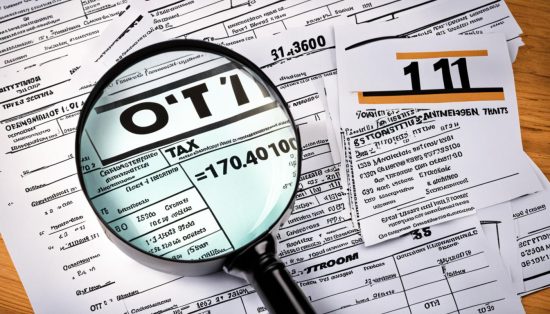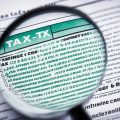Last Updated on: 27th April 2024, 11:15 am
The tax code OT/1 is used in the UK to indicate that an individual does not have any tax-free personal allowance to set against their taxable income. This code is often given to individuals who have started a new job and haven’t provided their employer with all the necessary information or when their personal allowance has been used up. The OT/1 tax code does not have a flat tax rate, and the amount of income tax paid depends on the individual’s earnings. It can range from 20% for basic rate taxpayers to 40% for higher rate taxpayers and 45% for additional rate taxpayers. If you have been on the OT/1 tax code and have overpaid income tax, you may be eligible for a tax rebate.
Understanding Your Tax Code
Tax codes in the UK provide vital information about an individual’s tax situation. They consist of numbers and letters and play a crucial role in determining how much tax an individual will pay. Let’s delve into the details of tax codes and understand their significance.
- Tax Code Explanation: Tax codes are a combination of numbers and letters that represent an individual’s tax-free income for a specific tax year. The numbers in the tax code indicate the amount of tax-free income an individual is entitled to. For example, a tax code of 1250L signifies a tax-free income of £12,500 for that tax year.
- Tax Code Calculation: The calculation of a tax code involves several factors. HMRC calculates tax codes based on an individual’s tax-free personal allowance, income that is not subject to tax, and any company benefits. These calculations determine the tax-free income an individual is entitled to and are reflected in the numbers of their tax code.
- Tax Code Allocation: The letters in a tax code represent an individual’s personal allowance and any additional calculations or adjustments that may affect it. These letters indicate whether an individual is receiving any special allowances or has specific deductions applicable to their tax situation.
- Updated Tax Code: Tax codes can be updated when an individual’s circumstances change, such as a new job, change in income, or changes to personal allowances. It is essential to keep your employer or pension provider updated with the correct information to ensure that your tax code accurately reflects your current tax situation.
- Tax Code Changes: Tax codes can change from year to year due to updates in tax legislation or changes in an individual’s circumstances. It is important to stay informed about any changes to your tax code to avoid any surprises and ensure that you are paying the correct amount of tax.
Understanding your tax code is crucial as it directly impacts the amount of tax you pay. Keeping your tax code updated with accurate information about your income and deductions is essential to avoid overpaying or underpaying income tax. If you have any questions or concerns about your tax code, you can reach out to HMRC for guidance and assistance.

Implications of Tax Code OT/1
The OT/1 tax code has significant implications for individuals when it comes to income tax. This tax code signifies that there is no tax-free personal allowance available. As a result, individuals with this tax code are required to pay more income tax compared to those with a different tax code.
The personal allowance is a predetermined amount of income that individuals can earn tax-free each year. However, without this allowance, all income becomes subject to taxation. It is important for individuals with the OT/1 tax code to understand the impact this has on their tax obligations and ensure that they are paying the correct amount of tax based on their earnings.
Understanding Tax Rules and Income Tax Calculations
To grasp the implications of the OT/1 tax code, it is vital to have a solid understanding of the governing tax rules and how income tax is calculated. Tax codes serve as indicators of an individual’s tax situation, consisting of both numbers and letters.
The numbers in a tax code represent the tax-free income an individual can earn within a given tax year, while the letters signify the personal allowance and any additional factors that affect it. HMRC calculates tax codes based on an individual’s tax-free personal allowance, income exempt from tax, and any company benefits.
By comprehending your tax code, you can better assess how much tax you will be required to pay. It is crucial to keep your tax code updated by providing accurate information about your income and deductions to your employer or pension provider.
The Significance of Personal Allowance and Tax Obligations
The personal allowance plays a vital role in determining the amount of income tax individuals are liable to pay. Those with the OT/1 tax code, lacking any tax-free personal allowance, will face higher income tax payments compared to individuals with different tax codes.
Understanding your tax obligations is crucial in ensuring that you comply with tax regulations and obligations. Without a tax-free personal allowance, individuals with the OT/1 tax code should be diligent in meeting their tax obligations by accurately reporting their income and paying the required amount of tax based on their earnings.
Personal Allowance vs. Tax Codes: A Comparative Overview
| Tax Code | Personal Allowance | Tax Rate |
|---|---|---|
| OT/1 | No tax-free personal allowance | Dependent on income and tax brackets: |
| Other Tax Codes | Available tax-free personal allowance | Varies based on income and tax brackets: |
As presented in the table above, the OT/1 tax code signifies the absence of a tax-free personal allowance. In contrast, other tax codes provide individuals with varying degrees of tax-free personal allowance based on their income and tax brackets.

The image above visually depicts the significance of tax codes, highlighting the influence of the OT/1 tax code on income tax obligations.
Updating Your Tax Code
If you believe that your tax code needs to be updated or if you suspect that it may be incorrect, there are steps you can take to rectify the situation. By following the appropriate procedures, you can ensure that your tax code accurately reflects your tax situation, helping you avoid potential issues such as overpaying or underpaying income tax.
1. Check your payslips, P45, or P60 forms
Start by checking your payslips, P45, or P60 forms to ensure that the correct information has been provided to your employer or pension provider. These documents contain important details related to your income, deductions, and tax code. Verify that all the information is accurate, including your National Insurance number, income, and any relevant deductions.
2. Contact HMRC
If you find any discrepancies or if your tax code needs updating, it is recommended to contact HMRC directly. They have several channels available for communication, including online, phone, or postal services. When reaching out, make sure to have your National Insurance number and provide as much information as possible about your income, employment, and any changes you require in your tax code.
3. Keep Track of Your Tax Code
Once your tax code has been updated, it is crucial to keep track of any further changes or updates to ensure its accuracy. Monitor your payslips and any communication from HMRC regarding your tax code. By staying informed, you can promptly address any discrepancies or issues that may arise.
Conclusion
Understanding and managing your tax code is vital to ensure the accurate payment of income tax. The OT/1 tax code indicates the absence of tax-free personal allowance, resulting in individuals paying more income tax. It is crucial to update your tax code if it is incorrect or requires modification. If you have been on the OT/1 tax code and have overpaid income tax, you may qualify for a tax refund. Keeping track of your tax code guarantees its alignment with your tax situation. If you have concerns or need assistance, consult HMRC for guidance.
FAQ
1. What does the OT/1 tax code mean?
The OT/1 tax code is used in the UK to indicate that an individual does not have any tax-free personal allowance to set against their taxable income. It is often given to individuals who have started a new job and haven’t provided their employer with all the necessary information or when their personal allowance has been used up.
2. How is the OT/1 tax code calculated?
The OT/1 tax code is calculated by HMRC based on the individual’s tax-free personal allowance, income not subject to tax, and any company benefits.
3. How much income tax will I pay with the OT/1 tax code?
The amount of income tax paid with the OT/1 tax code depends on the individual’s earnings. It can range from 20% for basic rate taxpayers to 40% for higher rate taxpayers and 45% for additional rate taxpayers.
4. Can I claim a tax refund if I have been on the OT/1 tax code?
Yes, if you have overpaid income tax while being on the OT/1 tax code, you may be eligible for a tax refund.
5. How can I update my tax code?
To update your tax code, check your payslips, P45, or P60 forms to ensure that the correct information has been provided. If necessary, contact HMRC directly with your National Insurance number and details about your income and employment.




















No Comments
Leave a comment Cancel